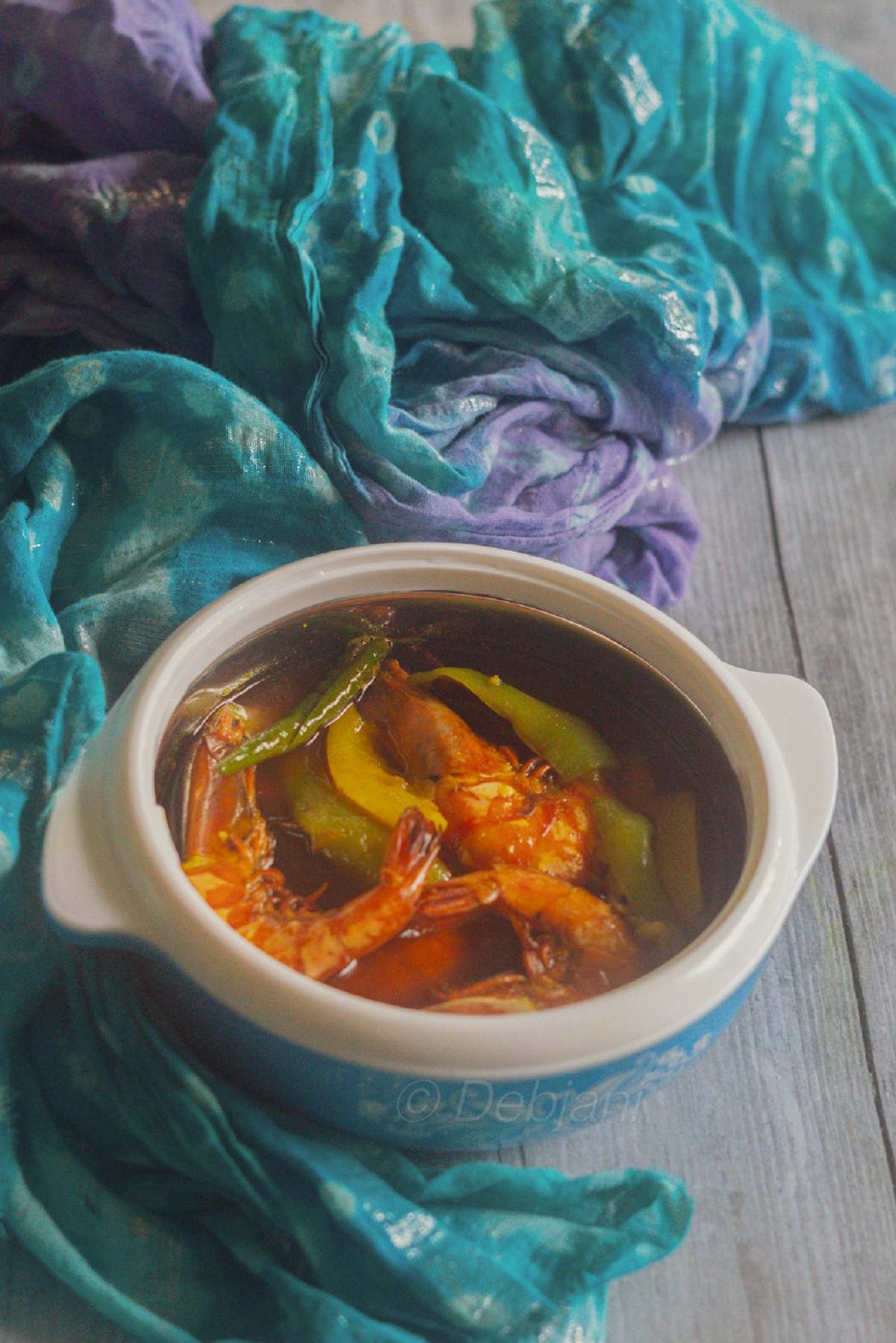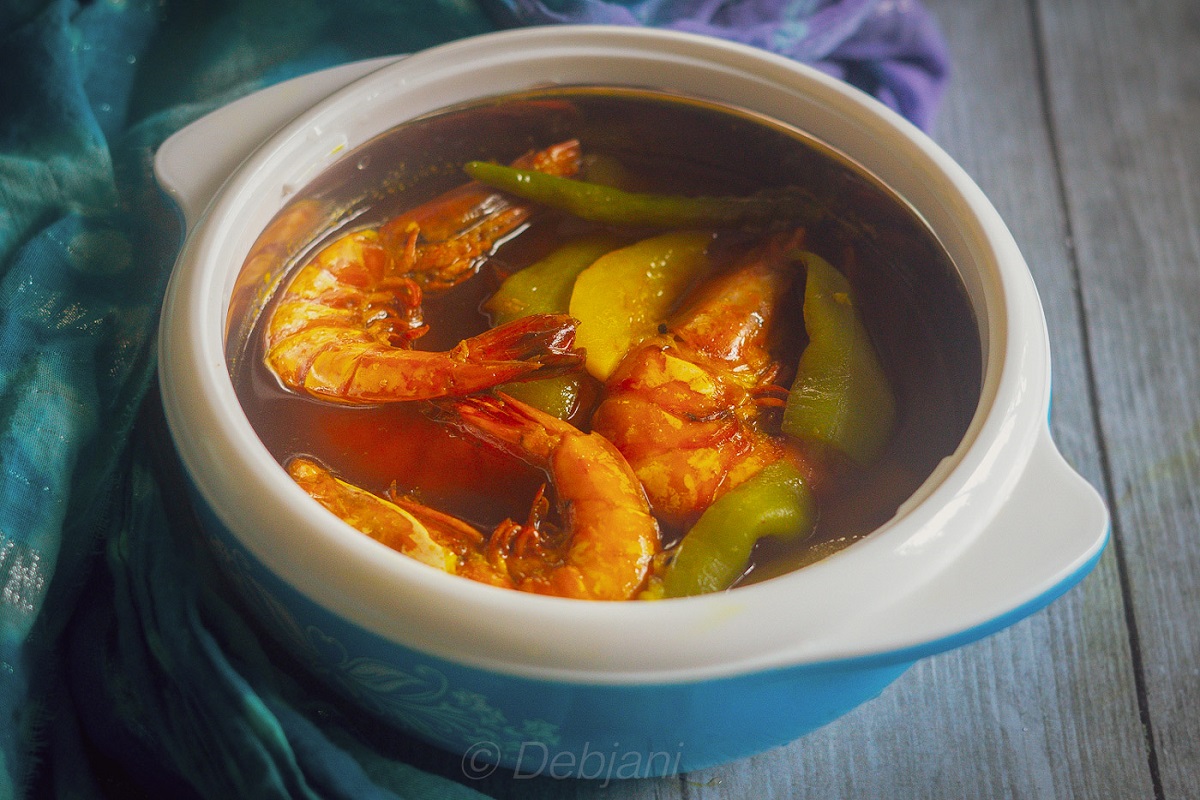Jhinge Aloo Chingrir Tel Jhol, also known as Jhinge diye Bagda Chingrir Tel Jhol is a simple, comforting runny curry. We cook this with Tiger Prawns and Ridge Gourd. It is quite popular in Bengali Ghoti households of Ghoti households. I suppose Bangals also cook a similar dish. However, this is a simple prawn curry recipe, neither rare nor complex.

I had this recipe written down for 3 years, but for some weird reason, I never posted it, even though I made a video for it. I thought let me post it on my YouTube channel "Debjanir Rannaghar" which isn't that big. If you're curious as to what happened, just keep reading until you get to the recipe!
Jump to:
- Ethics - a rare thing amongst food influencers and home chefs?
- Debjani's Note on Plagiarism in Recipe Writing
- Should we stop sharing well-researched and rare Recipes?
- Jhinge Aloo Chingrir Tel Jhol
- Ingredients
- Substitutions and Variations
- Top tip
- Recipe Card
- Jhinge Chingri Jhol - Video Recipe
- FAQ
- Related
- Pairing Jhinge Aloo Chingrir Tel Jhol
- Let's connect over the Jhinge Chingrir Tel Jhol recipe
- Jhinge Chicngrir Jhol pin for you
Ethics - a rare thing amongst food influencers and home chefs?
I remember a funny incident a few years ago with the Jhinge Aloo Chingrir Tel Jhol dish. It was part of gormei feast pop-up I was involved in, and when the creatives came, a bunch of home chefs in Kolkata suddenly started making the dish but called it Mohunbagan Chingri instead. This was because I was given the name Mohunbaganer Meye for the event. I found this incredibly amusing. So I asked my team to drop the dish.
I found it amusing that this was neither a difficult nor an uncommon recipe. Back then, I was quite aggravated at the time, similar to when two women (I won't mention their names) took my Ilish Panikhola Recipe, also known as Sada Ilish. They used it commercially and almost immorally. I observed them snooping around food writers, taking their work, and ultimately using it to make money off of recipes and ideas. Similar things happened with Mawaghater Ilish Bhorta (though not rare) and a few more dishes. Basically, one of them open my blog, copy and then create her menu. She copied others as well. She calls herself a home chef by the way. The other is almost similar, copies and shares recipes with her name.
Debjani's Note on Plagiarism in Recipe Writing
I'm well aware that there are other people who steal recipes from different sources. We, the ethical food writers or content creators don't assert that we created these dishes; rather, we always acknowledge the original creator if a dish is not a typical common one such as Kosha Mangsho or Butter Chicken. Even for Butter Chicken, I wrote the history involved. Unfortunately, it's not easy to come across this kind of behavior in our current times. For instance, there are certain Executive Chefs known to take recipes from cookbooks and present them as their own creations, and even some home chefs and influencers do this for cheap fame. Is this an ethical practice? What are your thoughts on this?
Should we stop sharing well-researched and rare Recipes?
My friends urged me to be cautious about what recipes I share on my blog. They advised me not to post my most special or rare recipes, because there have been instances where the recipes were taken and used in restaurants, cloud kitchens, and even five-star properties without giving me recognition. Home chefs and influencers have been guilty of stealing my recipes or from others and using them for commercial purposes. Although I'm taking their advice into consideration, I don't want to make my blog pointless by not sharing recipes.

I'm doing this to help people, so the least I expect is for my work to be credited. I know some people won't bother to credit me, but they're still using my blog. In a way, it benefits me either way. And for those who might be wondering, it's easy to tell the difference between the original and copies when it comes to food writers, content creators, and home chefs. In the long run, unethical tricks cannot make a person respectable and if there's no respect for you, fame is not something that you will get positively.
Jhinge Aloo Chingrir Tel Jhol

Let me come back to the recipe. This recipe for Jhinge Chingrir Tel Jhol is a classic Bengali prawn curry, made with Ridge gourd and potatoes. It's a popular dish that can be found in many Bengali cookbooks. I'm sharing my own simple version of this comforting curry, although it's never been known as Mohunbagan Chingri. I hope this post and recipe can be of use to you, and feel free to copy it.
Ingredients
The preparation of Jhinge Chingrir Jhol can vary significantly from family to family. Some may opt for the small, succulent Chapra chingri, while others might prefer the more substantial Golda chingri or Shrimp. In my home, however, we always go for the Bagda variety of prawns. Of course, the Ridge gourd is the main ingredient, but potatoes are often added to the mix as well. I also add garlic paste for extra flavor.

Substitutions and Variations
The recipe for Jhinge Chingrir Jhol is different from family to family. Some people like Chapra Chingri better than Bagda, while others use medium-sized Golda Chingri or Shrimp. Where I'm from, we tend to go for Bagda over Galda. Additionally, we combine it with Jhinge or Ridge Gourd and some potatoes. We also add a small amount of garlic paste, but not onion. Nevertheless, there are people who use both onion and ginger in the dish. Ultimately, it comes down to personal preference in terms of how to make the runny curry with prawns and Ridge gourd. Personally, I like to make it as comforting as possible.
Top tip
No matter the kind of prawns or shrimps you use, be careful not to fry them for too long, or else they will become too tough to eat!
Recipe Card

Jhinge Chingri Tel Jhol aka Jhinge diye Bagda Chingrir Tel Jhol
- Total Time: 25 minutes
- Yield: 6 Persons 1x
- Diet: Gluten Free
Description
Jhinge Aloo Chingrir Tel Jhol is a delightful Bengali recipe that combines fresh prawns, Ridge Gourd (also known as Jhinge in Bengali or Turai in Hindi), and Potato slices to make a comforting curry.
Ingredients
- 500g Bagda Chingri/ Tiger Prawns (use medium size, around 30 per kg)
- 1 Jhinge/ Ridge Gourd
- 1 Potato (big)
- 4 Green Chili
- 1 Tbsp. Garlic Paste
To Marinate Prawns:
- ½ Tsp. Turmeric Powder
- ½ Tsp. Red Chili Powder
- ½ Tsp. Salt
- 1 Tbsp. Mustard Oil
To marinate Veggies
- ¼ Tsp. Turmeric Powder
- ¼ Tsp. Salt
Tempering
- 1 Tsp. Nigella Seed/ Kalojire
Cooking Medium
- 6 Tbsp. Mustard Oil
Instructions
- Marinate 500g of cleaned prawns with 1 Tsp. of salt and ½ Tsp. turmeric powder and red chili powder as well.
- Stir in 1 Tbsp. of mustard oil, and leave the marinade for 15 minutes.
- Cut one potato and one ridge gourd into wedges after removing their skins.
- Then add ¼ Tsp. of salt and ¼ Tsp. of turmeric powder to the vegetables.
- Heat 5 Tbsp. of mustard oil in a pan.
- Fry 3-4 prawns at a time, keeping the flame at a medium level.
- Cook each side of the prawns for 30-45 seconds, and do not over-fry them as this will make them chewy.
- Once the prawns are done, set the remaining marinade aside.
- Add the potato wedges to the same oil.
- Fry for 3 minutes while stirring
- Then add the ridge gourd wedges and mix them together.
- Heat some oil in a pan and add ½ teaspoon of Nigella seeds or Kalojire.
- You can also do this step after removing the veggies from the pan, although I don't prefer this because it uses more oil.
- Push the veggies to one side of the pan, so that the oil is visible in the space created
- Next, add 1 tablespoon of garlic paste and mix it into the oil, stirring continuously for a minute until the garlic is fully cooked.
- Then, mix the veggies back in with the garlic-infused oil and the remaining marinade from the prawns.
- Cook for a minute, stirring constantly.
- Pour in 1 cup of water and stir again, then add 3-4 green chillis.
- Boil the mixture on a high flame.
- Add the fried prawns and another ¼ cup of water as well.
- Cook for two minutes, then stir in 1 tablespoon of mustard oil.
- Your Jhinge Chingrir Jhol is now ready!
- This comforting Bengali Prawn Curry is usually served with steamed rice.
Notes
- Instead of Tiger Prawns, you can use shrimp or Scampy.
- If needed, increase or decrease spices.
- You can replace mustard oil with other oils however in that case you will miss the signature flavor of mustard oil.
- Prep Time: 10 Min
- Cook Time: 15 Min
- Category: Side Dish
- Method: Cooking
- Cuisine: Bengali
Nutrition
- Serving Size: 100g
- Calories: 257
- Sugar: 1.3g
- Sodium: 488mg
- Fat: 17.4g
- Saturated Fat: 1.9g
- Carbohydrates: 8.1g
- Fiber: 1.4g
- Protein: 16.9g
- Cholesterol: 0mg
Jhinge Chingri Jhol - Video Recipe
FAQ
The small-headed prawns, commonly referred to as Tiger Prawns, are known as Bagda Chingri in Bengal. These prawns are usually found in brackish water and have a distinctive flavor and texture. On the other hand, prawns with large heads, popularly known as Scampi, are known as Galda Chingri in Bengal. Unlike Bagda Chingri, these prawns are found in freshwater. Galda Chingri has a sweet taste and is usually cooked in curries and other traditional Bengali dishes.
Related
Looking for other recipes like this? Try these:
- Pepe Chingri Ghonto | Bengali Raw Papaya Mishmash with Small Prawns (or Shrimp)
- Phulkopi Aloo diye Chingri Kaliya | Bengali Prawn Curry with Potato and Cauliflower
- Pui Chingri Ghonto aka Malabar Spinach Mishmash with Prawns (with Potato and Pumpkin)
- Shutki Chingri Bhorta | Dried Prawn Paste (Chingri Shutki Bhorta)
Pairing Jhinge Aloo Chingrir Tel Jhol
For sure steamed Rice! Below I am sharing a few dishes which can make a good meal along with the Jhinge Chingrir Jhol if served together.
Let's connect over the Jhinge Chingrir Tel Jhol recipe
Please inform me of your experience and feel free to send a photo to dolonchttrj@gmail.com. Additionally, you can find me on various social media platforms such as Instagram, YouTube, Facebook, Pinterest, Google News, X, and Thread. Don't forget to use the hashtag #debjanirrannaghar when sharing your attempts at my recipes or if you have any questions or recipe requests.
Jhinge Chicngrir Jhol pin for you


















Leave a Reply